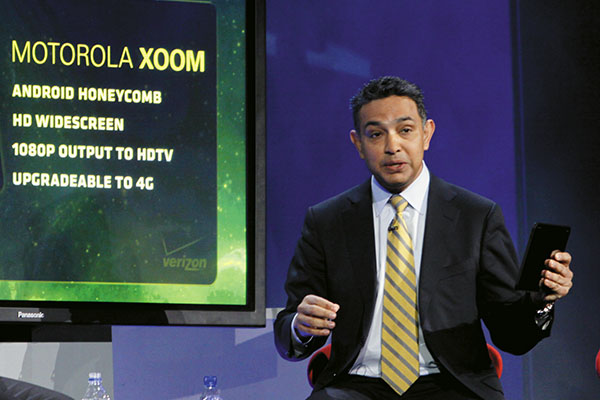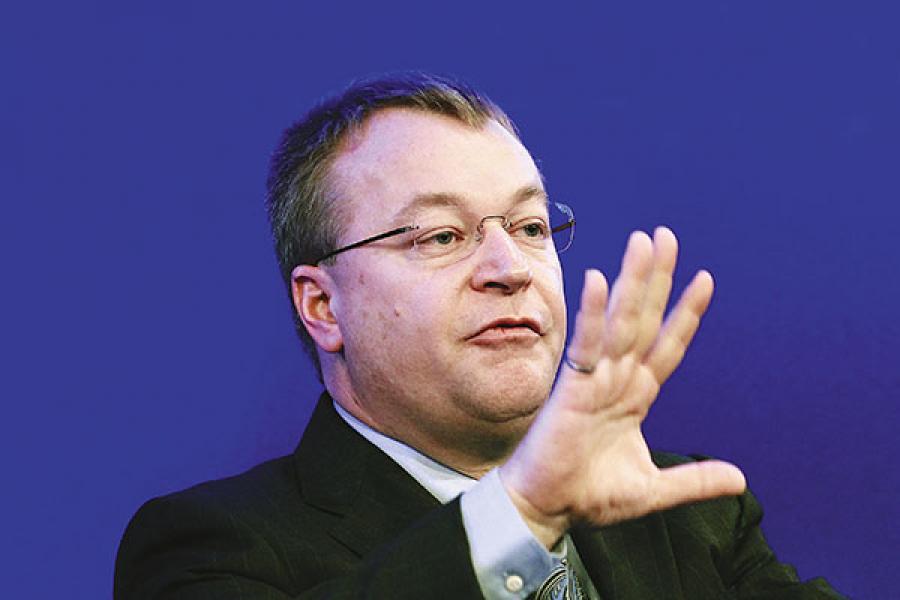
Is Nokia On the Brink of Oblivion?
Stephen Elop does not appear to be interested in eating my brain. At least not yet. The Nokia CEO is on a couch at the company’s San Francisco PR firm, holding court to show off Nokia’s latest flagship, the Windows Phone 8-powered Lumia 920. The brightly coloured device sits on a glass coffee table atop what looks like a small pillow but is an artfully designed wireless charging pad. Upbeat and gregarious, the Canadian-born Elop reveals his roots as he tells me “aboot” the new phones.
“The lens in here,” Elop explains, “is mechanically floated, and so as your hand shakes, as it naturally does, the lens moves in opposition to that to smooth out the shaking.” The new Lumia phones are boldly designed, have great maps (unlike, say, Apple) and vastly superior camera technology compared with the iPhone and Android models. And the Windows Phone ‘Metro’ user interface is as fluid as any OS out there.
But very quickly into our chat, Elop needles me over a web story I wrote in September that described Nokia and rival Research In Motion as the mobile industry’s equivalent of corporate zombies wandering the Earth with little chance to return to the land of the living. Elop was none too happy with having the 147-year-old company he’s been running for the last two years compared to creepy brain-eaters. Elop insists that the press and Wall Street’s harsh evaluation will be proven wrong. “People are just beginning to discover what experiences are possible with a device that’s packed with sensors, technology, computing power and cloud [access],” he said. “Things can change rapidly… It’s still a wide-open field.”
But let’s be clear: It’s not. In 2007 Nokia had a 37.8 percent share of the global handset market, ahead of Motorola with 14.3 percent and Samsung 13.4 percent, according to Gartner. Then came the iPhone and Android, showing up Nokia’s software as well behind the curve. Today Nokia’s share is down to 19.9 percent, behind Samsung at 21.6 percent. Most of the phones Nokia sells are low-margin, sub-$100 models targeted at emerging markets. Kulbinder Garcha at Credit Suisse predicts Nokia’s volume share will drop to 2.4 percent in 2013.
Since Elop took command in 2010, Nokia shares are down 75 percent. The company swung from $5.1 billion in profit in 2008 to losing $4.5 billion in the last 12 months. Its $4 billion in debt has been downgraded to junk status by S&P, Moody’s and Fitch.
Elop, the first non-Finn to run the company, has made several tough decisions. He replaced nine of 11 executives on Nokia’s leadership committee. Since September 2010 Nokia has announced 41,000 job cuts, including 17,000 in its telecom-equipment JV with Siemens. It shut down its remaining European handset factory in Salo, Finland and put the headquarters in Espoo on the block. Elop also streamlined a confusingly diverse array of handsets. In the last 12 months it unveiled under a dozen new smartphones when four years ago it would have rolled out twice as many. Elop has made headway on improving distribution in the US, where the company has had little presence in recent years.
Elop is a well-seasoned exec who did previous stints at Juniper, Adobe, Macromedia, Lotus and Boston Market. He was running the Office division at Microsoft when he was recruited to Nokia in September 2010. When he took the job Elop gushed about Nokia as “the undisputed leader of the mobile communications industry.” It didn’t take him long to figure out that the “undisputed leader” was in undisputed trouble. Less than six months after he arrived Elop wrote his famous “burning platform” memo to employees, which compared Nokia to a man standing at night on an oil rig in flames above the North Sea.
A few days later Nokia jumped into the icy water, announcing it would abandon its homegrown Symbian operating system in favour of Windows Phone software for all future smartphones. “It’s now a three-horse race,” he said at the time, the other two choices being Google’s Android OS and Apple’s iOS.
It was the only logical move to make. Had Nokia chosen Android, it would have been one more vendor in a crowd. With Windows Mobile, Nokia became Microsoft’s ticket to remaining relevant in mobile. But here’s the thing: Windows Phone has been running sixth in a three-horse race. The latest Gartner stats show that Windows has a mere 2.7 percent of global handset share, trailing Android, Apple, Symbian, BlackBerry and Samsung’s proprietary Bada OS. Just 4.1 million Windows phones were sold in the second quarter, including 4 million from Nokia. Android shipped 98.5 million phones and Apple, 28.9 million.
Elop appeared in New York two months ago with Microsoft CEO Steve Ballmer in tow to show off the same Nokia phones he showed me: The Lumia 920 and a lower-price version, Lumia 820. Nokia chose to get the jump on Apple by showing the press and Wall Street the new handsets a week before the debut of the iPhone 5. When they saw the phones Wall Street chose to jump out of the way. Nokia plunged 15 percent that day, as it failed to announce key details, like carrier partners and pricing. Nokia has since announced a deal to distribute the new phones with AT&T, but pricing still hasn’t been revealed. Meanwhile, Apple not only unveiled the iPhone 5 but also started selling it. Apple sold 5 million iPhone 5 units in the first weekend—more than the number of Lumia phones sold in Q2.
What can Elop do? One fix would be to get rid of noncore businesses. He sold off the luxury Vertu brand. The Nokia Siemens Networks equipment business will also be gone if Elop can find a buyer. Nokia’s 30,000 patents could be used more aggressively were the firm to be more litigious. Freeing up more cash could buy the company time to see if there really is a desire for a number three smartphone company.
Elop says it’s early, but it may be later in the evolution of the smartphone business than he’s willing to admit. Unless Nokia can figure out a way to lure consumers back to Nokia and away from Apple and Android, Elop might need to develop a taste for brains.
The Motorola Turn-and-Flip

CEOs looking to make dramatic transformations should learn from Sanjay Jha at Motorola. When Jha joined as co-CEO in 2008, Motorola’s share of the US mobile phone market was 7 percent, down from 60 percent in the late 1990s. Jha estimated that if he didn’t deliver killer products in 14 months, for Christmas 2009, Motorola was finished. Motorola had missed every major transition in the cellphone market—to 2G, to 3G, to colour, to camera, to touch, to QWERTY keyboards, as Jha noted. It was poised to miss smartphones, too.
Jha quickly diagnosed the situation, but, rather than just issuing orders, he worked within Motorola’s engineering culture. He met with top executives and others and personally reviewed key projects. He took the time to build trust and support. He rallied and focussed a demoralised organisation. Jha slashed costs and weeded out unpromising product lines before making his move: “Burn the ships and focus on Android.” By betting everything on Android, Jha married Motorola’s future with that of its biggest customer, Verizon, which desperately needed a response to AT&T’s exclusive iPhone deal. The Motorola Droid sold faster than the original iPhone. The Droid’s success also led to Google’s $12.5 billion acquisition of Motorola’s phone business in August 2011. In three years Jha almost doubled the company’s market capitalisation.
—Chunka Mui
(This story appears in the 23 November, 2012 issue of Forbes India. To visit our Archives, click here.)
-
 Malik B Modi
Malik B Modii guess Eric Savitz said correct. Elop now may have realized \"undisputed leader\" is in undisputed trouble.
on Jul 25, 2015 -
 Dr.a.jagadeesh
Dr.a.jagadeeshI used different mobiles ranging from iphone to China Phones but to me NOKIA is the best,user friendly and cost wise also affordable in developing countries. Dr.A.Jagadeesh Nellore(AP),India
on Sep 9, 2013 -
 Gaurav Baanga
Gaurav BaangaNokia missed the pulse of the market / customers which was shifting very fast to smart phones in 2008-09
on Nov 20, 2012















